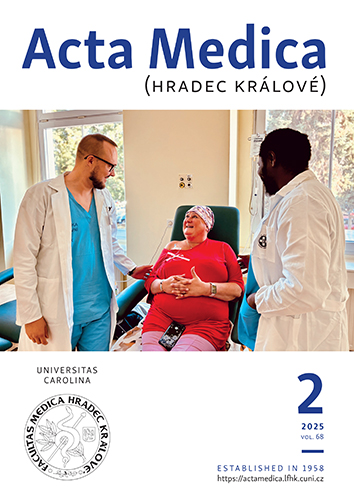ACTA MEDICA, Vol 59 No 4 (2016), 133–136
Transseptal Suturing Reduce Patient Anxiety after Septoplasty Compared to Nasal Packing
Kamran Sari, Ali Irfan Gul, Yunus Kantekin, Ozgul Karaaslan, Zeliha Kapusuz Gencer
DOI: https://doi.org/10.14712/18059694.2017.40
published online: 22. 02. 2017
abstract
Background: We measured postoperative anxiety in patients who underwent transseptal suturing or nasal packing after septoplasty. Materials and Methods: Transseptal suturing was performed on Group 1 patients and nasal splints with airway were placed after septoplasty in Group 2 patients. Postoperative 48-h anxiety levels of both groups were measured using the State-Trait Anxiety Inventory (STAI) clinical assessment scale, prior to removal of nasal packing in Group 2. Results: Transseptal suturing was performed after septoplasty in 28 patients and nasal packing in 34 patients. The State-Trait Anxiety Inventory clinical assessment state (STAI-S) and trait (STAI-T) instruments were used to measure postoperative anxiety. The STAI-S scores were found 35.00 in the transseptal suturing group and 43.8 in the nasal packing group; the difference was found significant (p < 0.05). The STAI-T scores were found 42.6 in the transseptal suturing group and 45.7 in the nasal packing group; the difference was not found significant (p > 0.05). The rate of minor hemorrhage was found 10.7% in Group 1 patients. Conclusions: Transseptal suturing is simple and reliable when performed after septoplasty. The technique is painless and comfortable, and reduces patient anxiety (compared to that associated with nasal packing) with only a minor increase in operating time and hemorrhage.
keywords: Septoplasty; Nasal packing; Transseptal suturing; Aanxiety

Transseptal Suturing Reduce Patient Anxiety after Septoplasty Compared to Nasal Packing is licensed under a Creative Commons Attribution 4.0 International License.
210 x 297 mm
periodicity: 4 x per year
print price: 150 czk
ISSN: 1211-4286
E-ISSN: 1805-9694
